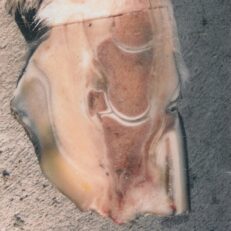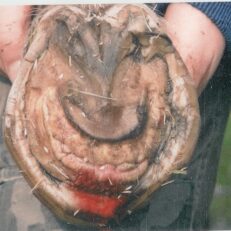Founder or Laminitis is one of the most damaging ailments for the horse’s hoof. The causes are varied but the effects are always the same with varying degrees of severity.
The two main causes are either an over-enriched diet coupled with a lack of exercise, or trauma to the horse through injury or sickness or stress.
Founder can be found in nearly any breed nowadays but is still more prevalent in ponies, which have a tendency to be overfed and under worked for their size. Most pastures in the settled areas are far too improved for horses (they were developed for dairy cattle) and are too rich in carbohydrates; this causes a high pulse rate which causes the laminae under the hoof capsule to swell in the toe area (like a blood blister under a thumbnail) and instant lameness. The horse starts to try and walk back on their heels, because this swelling causes the laminae to expand, pushing the sole down and the hoof capsule to turn up.
Trauma or stress founder has exactly the same effect; there are countless books on the subject written by specialists in this field, so I will only offer my opinion as a horseman and farrier.
The old-timers’ treatment for founder was to crash diet the horse if it was overweight, remove the shoes and trim the hoof flat at the toes, then stand him in a damp sand yard, the reasoning being that the wet sand cooled the hoof. Being barefoot allowed constant pressure on the soles to stop them from dropping. Often the horse would dig a hole to stand in where it was comfortable for the first couple of days then it would begin to stand normally as the hoof swelling subsided. Sore footed horses in the wild do this also, and the old timers knew if they didn’t mess with Mother Nature, things worked better and quicker.
Founder is life-changing for the horse forever after; the damaged laminae will never return to normal once it has been stretched. Owners need to be extremely vigilant and to monitor the horse’s condition to avoid the onset of this problem at all costs.


